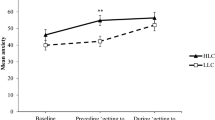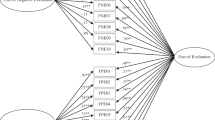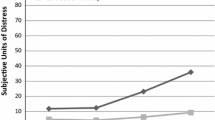Abstract
Emotion plays an important role in securing social stability. But while emotions like fear, anger, and guilt have received much attention in this context, little work has been done to understand the role that anxiety plays. That’s unfortunate. I argue that a particular form of anxiety—what I call ‘practical anxiety’—plays an important, but as of yet unrecognized, role in norm-based social regulation. More specifically, it provides a valuable form of metacognition, one that contributes to social stability by helping individuals negotiate the challenges that come from having to act in the face of unclear norms.
Similar content being viewed by others
Notes
Two points. First, on terminology: ‘anxiety’, as used in ordinary speech, philosophy, and psychology, refers to a range of phenomena that are unlikely to constitute a unified kind. So I will follow others in using the term to focus on varieties of anxiety concerned with uncertain threats and dangers. Second, because we do not have a settled account of what emotions are, I aim to be (largely) neutral regarding these debates.
This suggests that fear and anxiety were shaped by selective processes operating at both the individual and group level (with the later likely operating on both biological and cultural features of groups). While claims about multi-level selection are controversial, they are increasingly viewed as essential and plausible elements of explanations of human cooperation (e.g., Sterelny 2012, 2013; Kitcher 2011; Richerson and Boyd 2005; Fiske 2000). I return to this in “The upshot” section.
Work on baboons illustrates the distinct eliciting conditions and behavioral responses associated with these evolutionarily ancient forms of fear and anxiety (Cheney and Sayfarth 2007, 41–49). Spotting a lioness brings the immediate flight behavior distinctive of fear. Needing to cross a stream, by contrast, brings the risk minimization behaviors (e.g., novel stream crossing strategies) and information gathering (e.g., extended periods of observation) characteristic of anxiety. This makes sense given that fear is a response to obvious dangers (e.g., the lioness), while anxiety is a reaction to unclear ones (e.g., the crocodile that may be lurking beneath the stream’s surface).
The account of the functional differences between fear and anxiety noted in the text is supported by work showing differences between fear and anxiety at the neuroanatomical level. For instance, the evolutionary psychologist Michael Davis has demonstrated that fear and anxiety involve distinct brain structures: the central nucleus of the amygdala for fear, and the bed nucleus of the stria terminalis for anxiety (e.g., Walker et al. 2003; see also Kalin et al. 2001). For further discussion and defense of the need to see fear and anxiety as distinct emotions, see Öhman (2008); Gray and McNaughton (2000).
More precisely, fear is ballistic in the sense that tie between what elicits fear (e.g., the presence of a predator) and the subsequent behavior (e.g., flight) is very difficult to break. But it is flexible in the sense that what elicits fear and how an individual responds can vary depending on the kinds of threats that happen to be in the individual’s environment.
The idea that emotions like anger, fear, guilt, and disgust change the structure of one’s motivations is a central aspect of Robert Frank’s (1988) account of emotions as tools that commit individuals to acting in ways they otherwise would not. Additional support for emotions’ ability to affect one’s incentive structure comes from Paul Rozin’s work on disgust: coming to see a food item (e.g., a cockroach) as disgusting keeps one from eating it even after learning that it is completely safe (Rozen et al. 1986). Moreover, emotions other than fear (e.g., guilt, shame, pride) likely brought further enhancements to fear-driven dimension of norm internalization (Kitcher 2011; Boehm 2012; Fessler 2007).
As noted above, fear is better able to fulfill its role with regard to dominance-based social regulation because there’s a way for the subordinate to signal submission. Moreover, this need fits well with the fact that there is a distinctive fear expression. Anxiety, by contrast, is not associated a distinctive facial expression. But this makes sense given anxiety’s function: it’s a mechanism geared toward information gathering and risk minimization—a function that doesn’t require one to be able to signal to others that one is engaging in them.
Chimpanzees appear to have an even more robust (but still not human-like) theory of mind (Call and Tomasello 2008).
A more complete defense of the evolution of fear and anxiety as tools of social regulation would involve a more fine-grained investigation of the tuning of these emotions. We should expect to see, for instance, correlations between the complexity of these emotions and the complexity of particular hominoid social structures. We should also find more refined forms of fear and anxiety as we progress through the hominin lineage. While I cannot do that here (in part because much of the needed information does not exist), the reports of de Waal (1986) and Rilling et al. (2012) provide reason for optimism (also see note 10).
Work by the anthropologist Bruce Knauft (1991) indicates that increases in groups size not only brought greater normative uncertainty, but also greater violence—especially violence associated with resource access and status.
See Richerson and Boyd (2013) for discussion of the significant climatic changes that occurred during the Late Pleistocene—the period from which the transition from small-scale societies to larger ones likely began.
While I want to remain neutral on theories of emotion (recall footnote 2), setting that aside for the moment will help illustrate one way of fleshing out the relationship between punishment and practical anxiety sketched in the text. The earlier discussion of anxiety in non-human primates suggests that there is an anxiety affect program that can be shaped, at least to some extent, by environmental and social/cultural influences (Levenson 1999). Suppose that’s correct. If so, then what makes punishment and practical anxiety both forms of anxiety is that they both engage the anxiety affect program. What makes them distinct varieties of anxiety is that they give shape to the anxiety affect program through unique, functionally integrated combinations of situational sensitivities and behavioral responses.
Two elaborations: First, one might object that pointing to a pathological condition like scrupulosity fails to show that practical anxiety is a feature of normal individuals. This worry is misplaced. As Bunmi Olatunji and colleagues explain, “[a] substantial body of empirical research supports theoretical propositions that clinical obsessive–compulsive symptoms [including those associated with scrupulosity] have their origins in normally occurring phenomena…and that such symptoms occur on a continuum, with many individuals in the general population reporting subclinical obsessions and compulsions” (2007, 774; see also Marks and Nesse 1994). Second, while individuals suffering from scrupulosity will often exhibit both type-(a) and type-(b) behaviors, these two dimensions are disassociable (as indicated by the above case reports).
While the argument in the text makes a strong case for practical anxiety as a distinct form of anxiety, it’s worth noting that, even if this is wrong, we’ve still learned something important. That is, if practical anxiety turns out to just be ordinary anxiety brought on by a distinct set of cognitions (concerning, e.g., normative uncertainty), our investigation still highlights something that has gone unnoticed—namely, the important role that (practical) anxiety plays in facilitating social stability and accord.
While the need for broad community acceptance is, as we’ve seen (“A puzzle, a proposal” section), crucial in small-scale hunter-gatherer groups, it remains important even as group size increased and decision making became less egalitarian (Seabright 2010).
Though there is much controversy over how we should understand the evaluative content of emotions (e.g., is this content the result of a judgment? does the content have propositional form?), the general claim is widely accepted (e.g., Ekman 1992; Lazarus 1991; de Sousa 1987; Nussbaum 2001; Prinz 2004).
Understanding how, exactly, practical anxiety implicates normative uncertainty will turn on how best to understand how emotions get their content—is it, for instance, on par with perception (e.g., de Sousa 1987, Prinz 2004) or is it the result of a more cognitively rich appraisal (e.g., Lazarus 1991, Nussbaum 2001)? Fortunately for our purposes, we can be neutral on this issue.
One might object that the discussion in the text presumes that practical anxiety always manifests in a particular way: an automatic (pre-conscious) appraisal signals that one faces normative uncertainty which then brings deliberation and information gathering. But reflection on ordinary anxious experience suggests a different picture: ruminations and worries lead one to realize that one faces unclear norms which then prompts practical anxiety and so additional rumination and deliberation. This might suggest that practical anxiety doesn’t help us recognize normative uncertainty; rather, it merely helps us respond to normative uncertainty that we’ve identified via other means. In response, I do not deny that practical anxiety can come about through this alternative route. However, there’s no reason to think this is the only—or even the typical—way that individuals become practically anxious. First, empirical work on the appraisal processes that prompt anxiety indicates that anxious episodes are (typically) the upshot of automatic, pre-conscious mechanisms (see, e.g., the Mathew quote in the text). Second, empirical work also suggests that in cases where reflection brings anxiety, this alternative causal route is the upshot of specific (but atypical) triggers. For instance, clinical levels self-monitoring appear to engage feedback mechanisms that lead to anxiety-provoking levels of reflection (Barlow 2001).
MacKuen and colleagues talk generally about ‘anxiety,’ not ‘practical anxiety’ (that’s a term I’ve coined). But as the discussion in the text indicates, and as is readily apparent in their own presentation, they are picking out a particular variety of anxiety—one that is concerned with uncertainty about what to do rather than, say, uncertainty about how one might be evaluated (c.f., the discussion in the “Is practical anxiety a genuine psychological phenomenon?” section). For instance, there was little in the experimental design to make subjects think they were being observed or evaluated, and so little to suggest they were experiencing punishment rather than practical anxiety.
References
Abramowitz JS (2008) Scrupulosity. In: Abramowitz J, McKay D, Taylor S (eds) Clinical handbook of obsessive-compulsive disorder and related problems. Johns Hopkins Press, Baltimore, pp 156–175
Ackerman B, Fishkin J (2004) Deliberation Day. Yale University Press, New Haven
Barlow D (2001) Anxiety and Its disorders, 2nd edn. Guilford Press, New York
Baumeister R, Tice D (1990) Anxiety and social exclusion. J Soc Clin Psychol 9:165–195
Boehm C (1999) Hierarchy in the forrest. Harvard University Press, Cambridge, MA
Boehm C (2012) Moral origins. Basic, New York
Bradley B, Mogg K, Falla S, Hamilton L (1998) Attentional bias for threatening facial expressions in anxiety: manipulation of stimulus duration. Cogn Emot 12(6):737–753
Call J, Tomasello M (2008) Does the chimpanzee have a theory of mind? 30 years later. Trends Cogn Sci 12:187–192
Cheney D, Sayfarth R (2007) Baboon metaphysics. University of Chicago Press, Chicago
Chudek Z, Henrich J (2013) Culture-gene coevolution, large-scale cooperation, and the shaping of human social psychology. In: Sterelny K, Joyce R, Calcott B, Fraser B (eds) Cooperation and its evolution. MIT Press, Cambridge, pp 425–458
Cushman F (2013) The role of learning in punishment, prosociality, and human uniqueness. In: Sterelny K, Joyce R, Calcott B, Fraser B (eds) Cooperation and its evolution. MIT Press, Cambridge, pp 333–372
Darwin C (1873) The expression of the emotions in man and animals. D. Appleton, New York
de Sousa R (1987) The rationality of emotion. MIT Press, Cambridge
de Waal F (1986) The integration of dominance and social bonding in primates. Q Rev Biol 61:459–479
Ekman P (1992) An argument for basic emotions. Cogn Emot 6:169–200
Endler N, Kocovski N (2001) State and trait anxiety revisited. J Anxiety Disord 15:231–245
Fessler D (2007) From appeasement to conformity. In: Tracey J, Robins R, Tangney J (eds) The self-conscious emotions. Gilford, New York, pp 174–193
Fiske A (2000) Complementarity theory. Personal Soc Psychol Rev 4:76–94
Frank R (1988) Passions within reason. Norton, New York
Gibbard A (1990) Wise choices, apt feelings. Harvard University Press, Cambridge
Gray J, McNaughton N (2000) The neuropsychology of anxiety. Oxford University Press, Oxford
Kalin N, Shelton S, Davidson R, Kelley A (2001) The primate amygdala mediates acute fear but not the behavioral and physiological components of anxious temperament. J Neurosci 21:2067–2074
Kitcher P (2011) The ethical project. Harvard University Press, Cambridge
Knauf B (1991) Violence and sociality in human evolution. Anthr Res 32:391–409
Lazarus R (1991) Emotion and adaptation. Oxford University Press, New York
Leary M, Kowalski L (1995) Social anxiety. Guilford Press, New York
Levenson R (1999) The intrapersonal function of emotion. Cogn Emot 13:481–504
MacKuen M et al (2010) Civil engagements. Am J Polit Sci 54:440–458
Marks I, Nesse R (1994) Fear and fitness: an evolutionary analysis of anxiety disorders. Ethol Sociobiol 15:247–261
Mathews A (1990) Why worry? The cognitive function of anxiety. Behav Res Ther 28:455–468
Messer S (1970) The effect of anxiety over intellectual performance on reflection-impulsivity in children. Child Dev 41:723–735
Mogg K, Millar N, Bradley B (2000) Biases in eye movement to threatening facial expression in generalized anxiety disorder and depressive disorder. J Abnorm Psychol 109:1241–1252
Nussbaum M (2001) Upheavals of thought. Cambridge University Press, Cambridge
Öhman A (1986) Face the beast and fear the face. Psychophysiol 23:123–145
Öhman A (2008) Fear and anxiety. In: Lewis M, Haviland-Jones JM, Barrett LF (eds) Handbook of emotions. Gilford Press, New York
Öhman A, Mineka S (2001) Fears, phobias, and preparedness. Psychol Rev 108:483–522
Öhman A, Lundquist D, Esteves F (2001) The face in the crowd revisited. J Personal Soc Psychol 80:381–396
Olatunji B et al (2007) Scrupulosity and obsessive-compulsive symptoms. J Anxiety Disord 21:771–787
Perkins A, Corr P (2006) Reactions to threat and personality. Behav Brain Res 169:21–28
Prinz J (2004) Gut reactions. Oxford University Press, Oxford
Prinz J (2007) The emotional construction of morals. Oxford University Press, Oxford
Richerson P, Boyd R (2005) Not by genes alone. University of Chicago Press, Chicago
Richerson P, Boyd R (2013) Rethinking paleoanthropology. In: Hatfield G, Pittman H (eds) Evolution of mind, brain, and culture. University of Pennsylvania Press, Philadelphia, pp 263–302
Rilling JK, Scholz J, Preuss TM, Glasser MF, Errangi BK, Behrens TE (2012) Differences between chimpanzees and bonobos in neural systems supporting social cognition. Soc Cogn Affect Neurosci 7:369–379
Rozen Paul et al (1986) Operation of the laws of sympathetic magic in disgust and other domains. J Personal Soc Psychol 50:703–712
Seabright P (2010) The company of strangers. Princeton University Press, Princeton
Seyfarth R, Cheney D (2013) Affiliation, empathy, and the origins of theory of mind. Proc Natl Acad Sci 110:10349–10356
Smith T, Ingram R, Brehm S (1983) Social anxiety, anxious self-preoccupation, and recall of self-relevant information. J Personal Soc Psychol 44:1276–1283
Sterelny K (2012) The evolved apprentice. MIT Press, Cambridge
Sterelny K (2013) Life in interesting times. In: Sterelny K, Joyce R, Calcott B, Fraser B (eds) Cooperation and its evolution. MIT Press, Cambridge, pp 89–108
Sterelny K, Joyce R, Calcott B, Fraser B (2013) Cooperation and Its evolution. MIT Press, Cambridge
Tiedens L, Linton S (2001) Judgment under emotional certainty and uncertainty. J Personal Soc Psychol 81:973–988
Walker D, Toufexis D, Davis M (2003) Role of the bed nucleus of the stria terminalis versus the amygdala in fear, stress, and anxiety. Eur J Pharmacol 463:199–216
Acknoweldgments
An earlier version of this paper was presented at KU Leuven. Thanks to the participant of that conference for a helpful discussion. I have also benefited from conversations with Carl Craver, John Doris, Marta Halina, Ron Mallon, Anya Plutynski, Lizzie Schechter, and the participants in my graduate seminar on moral and philosophical psychology. Thanks as well to two anonymous referees and the Editor of the Journal for helpful suggestions.
Author information
Authors and Affiliations
Corresponding author
Rights and permissions
About this article
Cite this article
Kurth, C. Anxiety, normative uncertainty, and social regulation. Biol Philos 31, 1–21 (2016). https://doi.org/10.1007/s10539-015-9508-9
Received:
Accepted:
Published:
Issue Date:
DOI: https://doi.org/10.1007/s10539-015-9508-9




